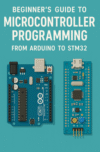At the foundation, every microcontroller—whether it’s an STM32, an ESP32, or a high-end NXP i.MX—exists because of semiconductor physics. A transistor isn’t magic; it’s a sandwich of doped silicon, engineered so that applying a tiny voltage can control the flow of current. Billions of these switches pack onto a die, and they flip at gigahertz speeds. But behind that speed is physics—quantum tunneling, carrier mobility, leakage currents—that engineers constantly wrestle with as nodes shrink. When you wonder why your MCU tops out at a certain frequency or why your IoT device drains its battery faster than expected, it often comes down to those stubborn physical realities.å
Embedded systems are everywhere—inside your microwave, your car’s ECU, even in the little black box controlling the elevator in your building. We talk about firmware, RTOS kernels, or cloud connectivity all the time, but we rarely stop to appreciate the physics holding the whole thing together. Strip away the code and abstractions, and embedded systems are really just carefully tamed electrons and electromagnetic fields dancing to our design.
Then there’s the analog world, which embedded engineers can’t ignore. Sensors measure light, temperature, pressure, or acceleration, and those quantities live in volts and currents, not neat digital bits. The job of an ADC is to discretize reality, but physics limits how clean that process can be. Noise, thermal fluctuations, and even stray electromagnetic interference from a nearby motor driver can smear your signal. That’s why PCB layout feels more like an art than just engineering—you’re literally shaping how electromagnetic fields propagate through copper traces.
Timing is another domain where physics refuses to be ignored. Real-time systems depend on precise oscillators, whether crystal-based or MEMS. Those oscillators vibrate in tune with the laws of mechanics and thermodynamics, and their stability defines how accurate your UART baud rate or PWM duty cycle really is. Ever had a serial link fail mysteriously between two boards? Often it’s not the software but the drift in clock frequencies, the inevitable result of atoms vibrating just a little faster or slower as temperature changes.
And let’s not forget power. Power supplies in embedded systems juggle switching regulators, capacitors, and inductors, each obeying Maxwell’s equations. That little decoupling capacitor sprinkled next to every IC pin isn’t a ritual—it’s there because electrons don’t move instantaneously. Voltage rails sag, currents surge, and without proper bypassing, your stable MCU can crash into chaos. It’s physics reminding us that no embedded system is purely digital.
What makes embedded design fascinating is how it sits at this intersection: abstract logic layered over stubborn, analog reality. Software engineers can afford to forget physics most of the time. Embedded engineers don’t get that luxury. A missed ground plane, a poorly chosen oscillator, or an underappreciated parasitic capacitance can sink an entire project.
So while we love to talk about protocols, drivers, and firmware updates, the truth is every blinking LED or smoothly spinning motor is a small victory over physics. The code only works because, somewhere underneath, the electrons are behaving as the designers predicted. And that constant negotiation between theory, material limits, and human ingenuity is what keeps embedded systems endlessly challenging—and endlessly rewarding.



